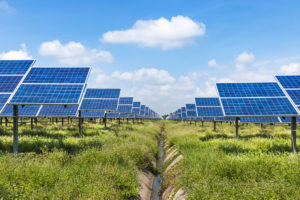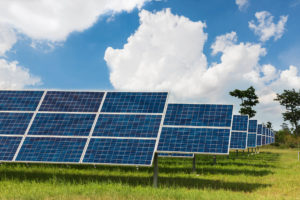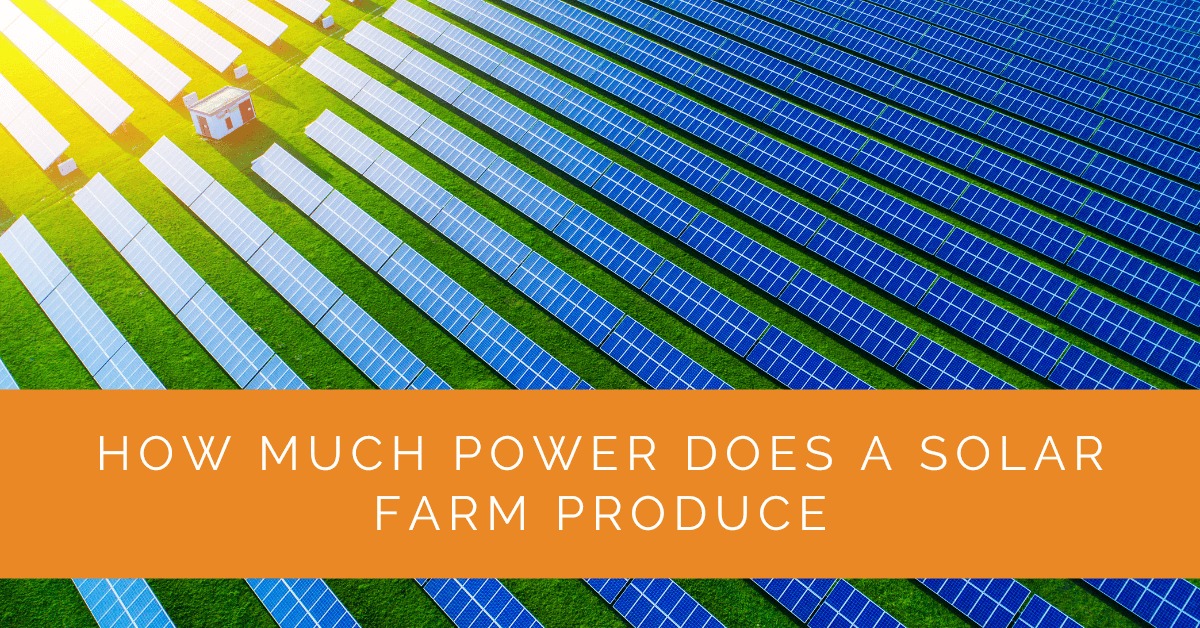Solar farms play a significant role in generating clean and renewable energy. Understanding the power output of solar farms is crucial for assessing their capacity and contribution to the electricity grid. In this article, we will explore the factors that influence the power generation of solar farms and delve into the calculations and performance ratios that determine their energy production.
Contents
- 1 Key Takeaways
- 2 Understanding Solar Farm Power Generation
- 3 Solar Farm Capacity
- 4 Examples of Different Size Solar Farms and Their Power Generation
- 5 Calculation of Solar Farm Power Output
- 6 Solar Farm Performance Ratio
- 7 Factors Influencing Solar Farm Power Production
- 8 Monitoring and Predicting Solar Farm Power Output
- 9 Case Studies
- 10 Future Trends in Solar Farm Power Generation
- 11 Case Study: Optimizing Solar Farm Power Production
- 12 Expert Insights From Our Solar Panel Installers About Solar Farm Power Production
- 13 Experience Solar Excellence with Us!
- 14 Conclusion
- 15 FAQ
Key Takeaways
- Solar farms produce significant amounts of power, with their capacity typically measured in megawatts (MW). A solar farm with a capacity of 10 MW has the potential to generate enough electricity to power thousands of homes.
- Various factors, such as solar irradiance, weather conditions, panel orientation, and shading, influence the actual power output of a solar farm. On a sunny day with optimal conditions, a 10 MW solar farm may produce approximately 30,000 kilowatt-hours (kWh) of electricity.
- Continuous monitoring, performance optimization, and technological advancements enhance the power generation of solar farms, making them more efficient and contributing to the growth of renewable energy. By implementing advanced tracking systems and high-efficiency solar panels, a solar farm’s power output can be increased by 10-20%, significantly boosting its overall energy production capacity.
Understanding Solar Farm Power Generation
Solar farms utilize photovoltaic (PV) technology to convert sunlight into electricity. These large-scale installations consist of multiple solar panels, also known as solar arrays, which collectively generate power. The power output of a solar farm depends on various factors, including capacity, solar irradiance, weather conditions, panel orientation, shading, and the performance of the installed PV system.
Solar Farm Capacity
Solar farm capacity is the maximum power a solar farm can generate under ideal conditions. It is typically measured in megawatts (MW) and represents the cumulative capacity of all the installed solar panels within the farm. The capacity of a solar farm is determined during the planning and design phase of the project, considering factors such as available land area, budget, and local regulations.

Examples of Different Size Solar Farms and Their Power Generation
Solar farms come in various sizes, and their power generation capacity depends on factors like solar irradiance, panel efficiency, and overall system design. Here are some examples of different size solar farms and the power they can generate:
- Small-Scale Solar Farm (1 MW): A small-scale solar farm with a capacity of 1 megawatt (MW) can produce approximately 1.5-2.5 million kilowatt-hours (kWh) of electricity per year. This is enough to power around 150-250 average-sized homes.
- Medium-Scale Solar Farm (10 MW): A medium-scale solar farm with a capacity of 10 MW can generate roughly 15-25 million kWh of electricity annually. This power can meet the energy needs of approximately 1,500-2,500 homes.
- Large-Scale Solar Farm (100 MW): A large-scale solar farm with a capacity of 100 MW has the potential to produce around 150-250 million kWh of electricity per year. This is equivalent to powering approximately 15,000-25,000 homes.
- Utility-Scale Solar Farm (1 GW): Utility-scale solar farms are massive installations with a 1 gigawatt (GW) capacity or more. A 1 GW solar farm can generate impressive power, estimated at 1.5-2.5 billion kWh annually. This is sufficient to supply electricity to hundreds of thousands of homes.
It’s important to note that these examples provide approximate power generation figures based on average conditions and may vary depending on location, panel efficiency, and other project-specific factors. The advancements in technology and ongoing improvements in solar panel efficiency continue to enhance the power generation capabilities of solar farms, making them increasingly valuable contributors to our renewable energy mix.
Calculation of Solar Farm Power Output
The power output of a solar farm is determined by multiplying its capacity by the number of hours it operates and the solar irradiance received during that period. This calculation yields the total energy produced, measured in megawatt-hours (MWh) or kilowatt-hours (kWh). The power output may vary based on weather conditions, shading, panel efficiency, and system losses.
Solar Farm Performance Ratio
A solar farm’s performance ratio (PR) is a metric used to evaluate its overall efficiency. It represents the ratio of the energy produced by the solar farm to the theoretical maximum energy produced under ideal conditions. A higher PR indicates a more efficient solar farm. System losses, temperature variations, and shading affect the PR.

Factors Influencing Solar Farm Power Production
Several factors influence the power production of a solar farm:
- Solar Irradiance: The amount of sunlight the solar panels receive is a crucial factor in power production. Higher solar irradiance levels increase power output, while lower levels can reduce energy generation.
- Weather Conditions: Weather patterns, including temperature, humidity, and cloud cover, affect the performance of solar farms. Higher temperatures can reduce panel efficiency, while clouds and excessive humidity can decrease solar irradiance and power output.
- Orientation and Tilt of Solar Panels: Solar panels’ orientation and tilt angles impact the amount of sunlight they receive. Optimal orientation ensures that panels capture the maximum available solar energy throughout the day, optimizing power generation.
- Shading and Obstructions: Shading from nearby buildings, trees, or other structures can significantly impact solar farm power production. Identifying and mitigating shading to maximize energy generation and maintain consistent performance is crucial.
Monitoring and Predicting Solar Farm Power Output
Real-time monitoring systems are vital for tracking the power output of solar farms. These systems provide insights into the performance of individual panels, identify issues or inefficiencies, and optimize energy production. Additionally, predictive tools and models can estimate solar farm power output based on historical data, weather forecasts, and performance trends.
Case Studies
Examining successful solar farm projects provides insights into their power output and the factors contributing to their success. Case studies highlight utility-scale solar installations that have achieved significant power generation, showcasing the potential of solar farms as reliable sources of renewable energy.
Future Trends in Solar Farm Power Generation
Solar farm power generation continues to evolve with technological advancements and industry trends. Emerging technologies, such as advanced solar panels with higher efficiency and improved energy storage systems, are enhancing solar farms’ power output and reliability. Additionally, innovations in tracking systems, artificial intelligence, and predictive analytics optimize energy generation by maximizing solar panel performance and adjusting system parameters based on real-time conditions.
Case Study: Optimizing Solar Farm Power Production
Background
A solar energy company sought to optimize the power output of one of their 10 MW solar farms. Located in a region with abundant sunlight, the farm was expected to produce significant amounts of electricity, contributing to the local grid and supporting renewable energy goals. The company aimed to enhance the farm’s performance through advanced monitoring and technological upgrades.
Project Overview
The project focused on maximizing the energy generation of the 10 MW solar farm. The key objectives were to identify factors affecting power production, implement advanced tracking systems, and upgrade the solar panels to newer, more efficient models.
Implementation
Site Assessment and Planning: The initial phase involved a thorough assessment of the site to identify areas for improvement. This included analyzing solar irradiance, shading patterns, and panel orientation. The assessment revealed that some areas of the farm experienced intermittent shading from nearby trees, which affected overall energy production.
Technological Upgrades: To address these issues, the company decided to upgrade the solar panels to high-efficiency models capable of generating more power even in suboptimal conditions. Additionally, they installed advanced solar tracking systems to ensure panels maintained the optimal angle relative to the sun throughout the day.
Shading Mitigation: The team also took measures to mitigate shading. This involved strategic trimming of nearby trees and installing anti-reflective coatings on the panels to reduce the impact of shadows and increase sunlight absorption.
Performance Monitoring: A state-of-the-art monitoring system was implemented to provide real-time data on the farm’s performance. This system tracked the output of individual panels, identified inefficiencies, and allowed for quick intervention when issues arose. Predictive analytics tools were also used to forecast energy production based on weather patterns and historical data.
Results
Following the upgrades and optimizations, the solar farm’s power output increased significantly. The high-efficiency panels and tracking systems boosted energy generation by approximately 15%. The monitoring system proved invaluable in maintaining optimal performance, as it allowed for rapid identification and resolution of any issues affecting production.
The enhanced performance translated into a substantial increase in electricity fed into the grid, supporting the local community’s energy needs and contributing to the broader renewable energy goals. The project also demonstrated the financial viability of investing in technological upgrades, as the increased energy production led to higher revenues and a quicker return on investment.
Summary
This case study highlights the importance of continuous optimization in solar farm operations. By upgrading to high-efficiency panels, implementing advanced tracking systems, and employing real-time performance monitoring, the solar energy company successfully increased the power output of their 10 MW solar farm. These improvements not only enhanced the farm’s contribution to the electricity grid but also demonstrated the economic and environmental benefits of investing in modern solar technologies. As solar farms continue to play a crucial role in renewable energy production, ongoing innovations and optimizations will be essential in maximizing their efficiency and impact.
Expert Insights From Our Solar Panel Installers About Solar Farm Power Production
The power output of a solar farm is influenced by numerous factors, including panel orientation, weather conditions, and shading. Understanding these variables is crucial for optimizing performance and ensuring maximum energy generation.
Continuous monitoring and maintenance are key to maximizing a solar farm’s efficiency. By implementing advanced tracking systems and addressing issues promptly, we can significantly boost the overall power output.
Technological advancements in solar panels have drastically improved their efficiency. New high-efficiency panels can increase a solar farm’s energy production by 10-20%, making them a vital component in meeting renewable energy goals.
Experience Solar Excellence with Us!
Trust in Solar Panels Network USA, where our seasoned experts deliver top-quality solar solutions for homes and businesses nationwide. With a legacy of countless successful installations and a commitment to sustainable energy, we’re your reliable partner in the solar journey. Ready for a brighter, eco-friendly future? Call us now at (855) 427-0058 and harness the power of the sun!
Conclusion
Solar farms are integral to the generation of clean and renewable energy. Understanding the power output of these large-scale installations is essential for assessing their capacity, efficiency, and contribution to the electricity grid. Factors such as solar irradiance, weather conditions, panel orientation, shading, and system performance influence the power production of solar farms.
Solar farm operators and stakeholders can assess the effectiveness of their installations and make informed decisions regarding maintenance, optimization, and expansion by calculating the power output, monitoring performance, and evaluating the performance ratio.
As solar farms continue to play a vital role in the transition to sustainable energy, ongoing advancements in technology and industry practices will further improve their power generation capabilities. By harnessing the power of solar energy, we can reduce our dependence on fossil fuels, lower greenhouse gas emissions, and contribute to a cleaner and more sustainable future.
FAQ
How much energy does a 1-acre solar farm produce?
The energy production of a 1-acre solar farm depends on various factors such as solar irradiance, panel efficiency, and system performance. On average, a well-designed 1-acre solar farm can generate approximately 1,000,000 kilowatt-hours (kWh) of electricity annually.
How much money can a 100-acre solar farm make?
The financial returns of a 100-acre solar farm depend on several factors, including local energy prices, government incentives, and operating expenses. A well-performing 100-acre solar farm can generate substantial revenue, potentially earning several million dollars annually.
How big is a 1 MW solar farm?
The physical size of a 1 megawatt (MW) solar farm can vary depending on the efficiency and capacity of the solar panels used. As a rough estimate, a 1 MW solar farm may require approximately 4-5 acres of land, although specific designs and technologies can influence the actual size.
How much electricity can a solar farm produce?
The electricity production of a solar farm depends on factors such as its capacity, solar irradiance, panel efficiency, and operating conditions. A typical solar farm with a capacity of 1 MW can produce around 1.5-2.5 million kilowatt-hours (kWh) of electricity per year. However, specific numbers can vary based on location and other factors.
About the Author
Solar Panels Network USA stands at the forefront of solar energy solutions, driven by a team of seasoned solar engineers and energy consultants. With over decades of experience in delivering high-quality solar installations and maintenance, we are committed to promoting sustainable energy through customer-centric, tailored solutions. Our articles reflect this commitment, crafted collaboratively by experts to provide accurate, up-to-date insights into solar technology, ensuring our readers are well-informed and empowered in their solar energy decisions.

